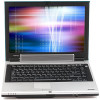Toshiba Satellite M55-S329 Toshiba Online Users Guide for Satellite M50/M55 - Page 97
Using your computer at the office, Backing up your work, Restoring your work - restore disk
 |
View all Toshiba Satellite M55-S329 manuals
Add to My Manuals
Save this manual to your list of manuals |
Page 97 highlights
Learning the Basics Using your computer at the office 97 Using your computer at the office By connecting an external monitor, external full-size keyboard, and a mouse, you can work with your notebook as if it were a standard office computer. An external monitor or projector connects to the RGB (monitor) port. Any USB device can connect to the USB ports. Backing up your work Back up all the files you create in case something happens to your computer. You can back up your files to different types of media such as CDs, DVDs, diskettes, or to a network, if available. To back up several files at one time, use the Microsoft® Windows® backup program preinstalled on the computer's hard disk. For more information, see "Backing up your data to CDs with Windows XP" on page 208. HINT: Backing up all the files on your hard disk may take a considerable amount of time and multiple CDs/DVDs. You may prefer to use a high-capacity backup system, such as an external hard drive. Small files can be backed up on diskettes if an optional external diskette drive is available. Restoring your work To restore information from your backup media to your hard disk, use the Restore page in the backup program. Look in the















